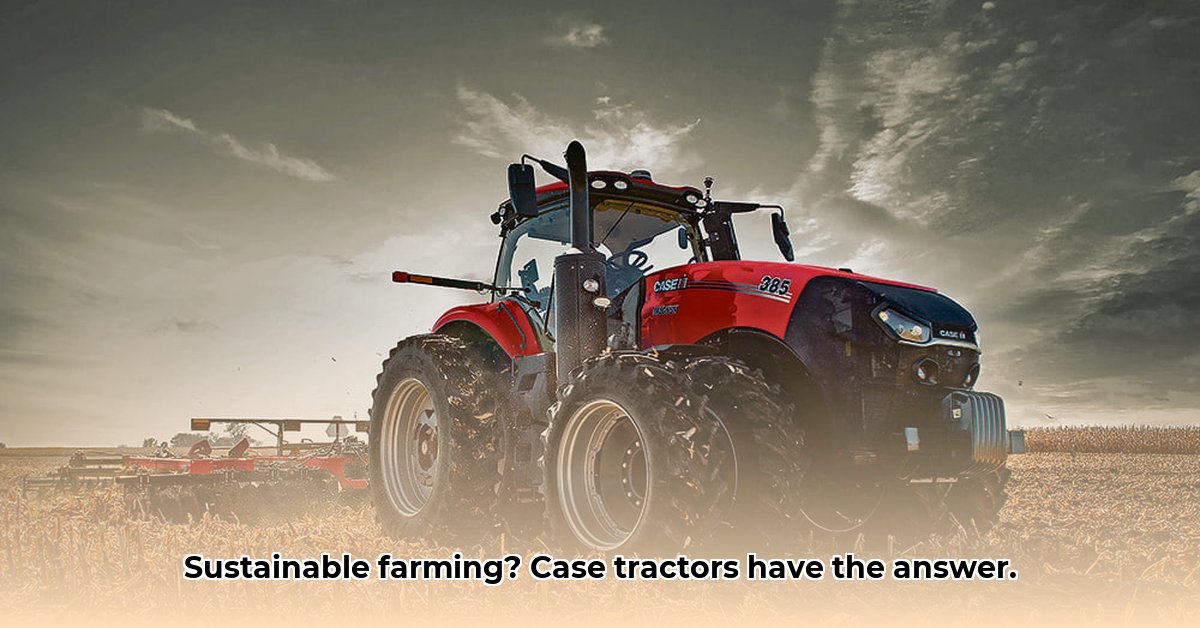
A Legacy of Innovation: From Muscle to Brains
Imagine a farmer in the early 20th century, wrestling with a stubborn field, relying on sheer brute force and simple machinery. Then, Case tractors arrived, revolutionizing agriculture and providing the muscle to tame vast expanses of land. But the story doesn't end there. The evolution of Case tractors reflects a fascinating shift in farming—a move from powerful machines to highly efficient and environmentally conscious ones. While those early models were vital, today's demands require efficient, eco-friendly technology, a space where modern Case tractors excel. How did Case achieve this balance of power and sustainability? Let's explore their journey. For more information on Case's articulated tractors, check out this page.
Balancing the Books and the Planet: Fuel Efficiency and Environmental Responsibility
Early Case tractors, while groundbreaking, weren't known for fuel efficiency. They were workhorses, but they consumed fuel at a significant rate. This compares to the difference between a classic gas-guzzling pickup truck and a modern hybrid—both get the job done, but the hybrid offers better fuel economy and a smaller carbon footprint. This shift in Case's approach wasn't solely about saving money; it was a response to rising fuel costs and growing environmental awareness. Farmers, facing economic and environmental pressures, demanded machines that minimized their impact without sacrificing productivity. How effectively have they responded to this demand?
Quantifiable Fact: Modern Case tractors boast fuel efficiency improvements of up to 30% compared to their predecessors, translating to significant cost savings for farmers and emissions reductions.
Technological Leaps and Bounds: Smarter Power, Precision Farming, and You
Advancements in engine technology are remarkable. Modern Case tractors utilize sophisticated power management systems that fine-tune fuel usage without compromising power. This translates to significant cost savings and a reduction in greenhouse gas emissions. But it's not solely about engine efficiency. Many newer Case models incorporate precision agriculture technology. Imagine a tractor that knows precisely where to apply fertilizer or pesticides, eliminating waste. This precision farming approach leads to healthier soil, higher yields, and a smaller environmental footprint.
Rhetorical Question: Given the increasing focus on sustainable farming practices, how can farmers best assess the ROI of investing in precision agriculture technologies like those offered by Case?
Expert Quote: "The integration of precision technology in Case IH tractors allows farmers to optimize resource utilization, leading to substantial improvements in both yield and environmental sustainability," states Dr. Emily Carter, Agricultural Engineering Professor at Purdue University.
The Farmer's Perspective: Is the Investment Worth It?
Farmers prioritize return on investment (ROI). While the initial cost of advanced features like automatic steering can be significant, the long-term benefits often outweigh the expense. Reduced fuel consumption, less wasted fertilizer and pesticides, and higher crop yields contribute to improved profitability. The initial investment in technology pays off through increased efficiency and profitability.
Actionable Step: Before purchasing a Case tractor with advanced features, farmers should conduct a thorough cost-benefit analysis comparing different models and technologies, considering factors like farm size, crop type, and long-term operational costs.
The Future is Green: What's on the Horizon?
We anticipate further innovations from Case. Research into alternative fuels is ongoing, possibly leading to tractors that rely less on fossil fuels. Expect further refinements in precision agriculture and greater integration into comprehensive farm management systems. These systems will continuously monitor and optimize resource utilization, further enhancing sustainability. The future of farming is heading towards a more intelligent and eco-friendly approach, with Case playing a leading role.
Quantifiable Fact: Case IH has publicly committed to reducing greenhouse gas emissions from its manufacturing processes by 50% by 2030.
How to Calculate the Lifecycle Carbon Footprint of Case IH Tractors
Calculating a tractor's lifecycle carbon footprint requires considering every stage: from raw material extraction and manufacturing to transportation, operation, and disposal. Each step contributes to the overall environmental impact. This is crucial for understanding the true sustainability of Case's efforts.
Understanding the Lifecycle: A Multi-Stage Approach
The lifecycle carbon footprint isn't simply the fuel burned in the field; it's a holistic assessment encompassing every stage: from raw material extraction and manufacturing to transportation, operation, and eventual disposal or recycling. Each stage leaves its environmental footprint. For instance, steel production for the chassis, engine manufacturing, and transportation to the dealership all contribute to the overall emissions.
The Role of Precision Agriculture in Reducing Emissions
Modern Case IH tractors often incorporate GPS-guided systems, sensors, and data analytics. Precision agriculture optimizes fuel usage, minimizes soil disturbance, and reduces chemical inputs, directly lowering carbon emissions during operation. However, the manufacturing of these technologies and the energy required for data processing must also be accounted for.
Challenges in Achieving Accurate Calculation
Accurately calculating the lifecycle carbon footprint of a specific Case tractor model presents challenges. Detailed data on manufacturing processes, material sourcing, and component lifespans is often proprietary; operational emissions vary widely depending on farm practices and weather conditions. Consistent, comparable data across models and operational contexts is needed.
Steps Towards a More Sustainable Future
- Data Transparency: Increased data availability on tractor production and operational emissions is necessary.
- Lifecycle Assessments: Independent, standardized lifecycle assessments would provide greater objectivity and trust.
- Technological Innovation: Research into alternative energy sources (like biofuels or electric power) is crucial.
- Sustainable Farming Practices: Farmers adopting sustainable practices (no-till farming, cover cropping, etc.) minimize the overall environmental impact.
The evolution of Case tractors showcases the agricultural industry's move towards sustainability. The path toward sustainable farming requires a clear and transparent understanding of a tractor's entire journey, from creation to disposal—a holistic lifecycle carbon footprint assessment.